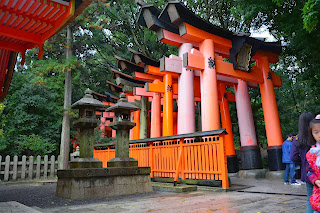In the hills east of Kyoto is the main shrine to the Shinto god Inari, patron saint of rice, foxes, fertility, tea, saki, swordsmiths and merchants. But more importantly, Inari (a genderless spirit, a kami) is the patron of modern business in Japan. For success in business, turn to Inari. And the Japanese do that in droves: there are an estimated 32,000 Inari shrines in Japan (according to Wikipedia.)
We arrived at this shrine late in the day; officially it closed at dusk and I was worried we wouldn't be able to see much. But only the worship hall of the main shrine (the haiden in the photo above) closed at dusk; the grounds remained open long after dark. Besides the main shrine there were hundreds and hundreds of smaller shrines that could be visited.
There were statues of foxes all over the place. In western mythology (at least in the United States) the fox is "wily" and is known for getting into chicken coops. But in Shintoism, the fox is the messenger of the god Inari and it holds a key in its mouth. It's the key to the rice granary.
After looking at the main shrine we approached the start of a path through the woods.
The path was lined with torii, the traditional Shinto gates. I thought this was interesting because the torii were so close together as well as being brightly colored. I had to wait a while until most people were out of the picture. Then I turned the corner:
I loved this view. Several other people waited with me to get this photo. Then we began to walk through the torii and found that there were more torii:
...and more torii:
I couldn't believe how many there were. There were literally thousands.
Then, turning around...
...we saw that they were all labeled. Turns out that all the torii were donated by businesses and individuals. The inscriptions record the donor and the date of the donation. According to Wikipedia each torii costs $4,000-10,000. They line paths that climb the mountain for several kilometers.
At several places along the path there were clusters of shrines.
At all shrines and temples you can buy something as a prayer gift, typically a candle, paper with a prayer on it, or a shingle of wood where you can write your own prayer. The Fushimi-Inari shrine has its own twist on the idea:
Buy your own torii and present it as a gift to the shrine of your choice.
The Fushimi-Inari shrine is an impressive complex, and walking it at dusk was a special experience. The thousands and thousands of torii makes it a unique place.
For more photos see the Fushimi-Inari photo gallery.
We arrived at this shrine late in the day; officially it closed at dusk and I was worried we wouldn't be able to see much. But only the worship hall of the main shrine (the haiden in the photo above) closed at dusk; the grounds remained open long after dark. Besides the main shrine there were hundreds and hundreds of smaller shrines that could be visited.
There were statues of foxes all over the place. In western mythology (at least in the United States) the fox is "wily" and is known for getting into chicken coops. But in Shintoism, the fox is the messenger of the god Inari and it holds a key in its mouth. It's the key to the rice granary.
After looking at the main shrine we approached the start of a path through the woods.
The path was lined with torii, the traditional Shinto gates. I thought this was interesting because the torii were so close together as well as being brightly colored. I had to wait a while until most people were out of the picture. Then I turned the corner:
I loved this view. Several other people waited with me to get this photo. Then we began to walk through the torii and found that there were more torii:
...and more torii:
I couldn't believe how many there were. There were literally thousands.
Then, turning around...
...we saw that they were all labeled. Turns out that all the torii were donated by businesses and individuals. The inscriptions record the donor and the date of the donation. According to Wikipedia each torii costs $4,000-10,000. They line paths that climb the mountain for several kilometers.
At several places along the path there were clusters of shrines.
At all shrines and temples you can buy something as a prayer gift, typically a candle, paper with a prayer on it, or a shingle of wood where you can write your own prayer. The Fushimi-Inari shrine has its own twist on the idea:
Buy your own torii and present it as a gift to the shrine of your choice.
The Fushimi-Inari shrine is an impressive complex, and walking it at dusk was a special experience. The thousands and thousands of torii makes it a unique place.
For more photos see the Fushimi-Inari photo gallery.










No comments:
Post a Comment